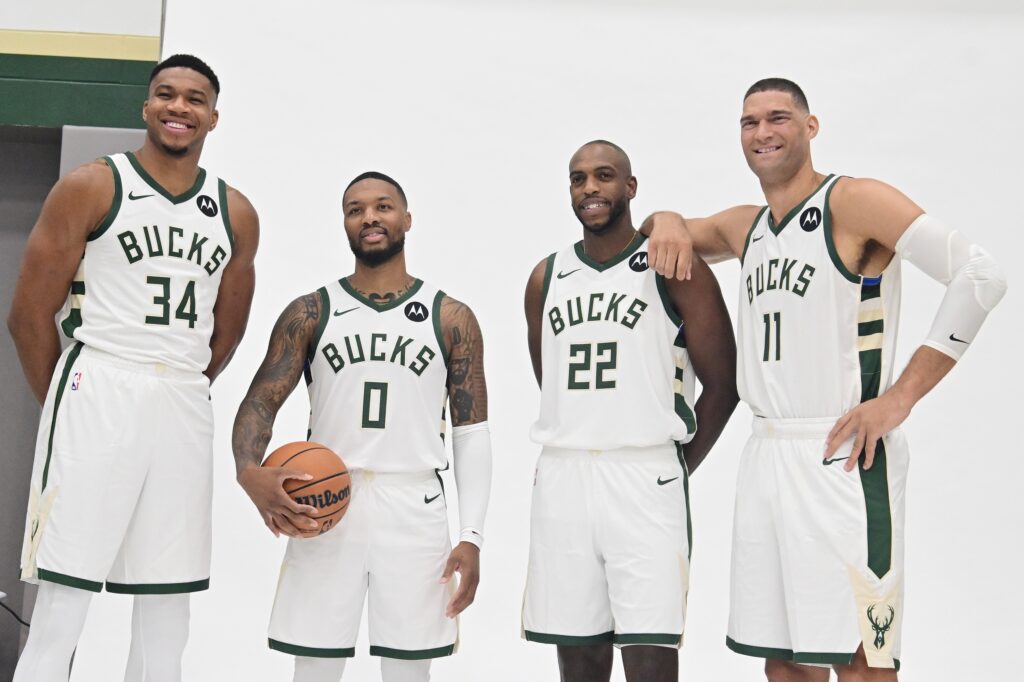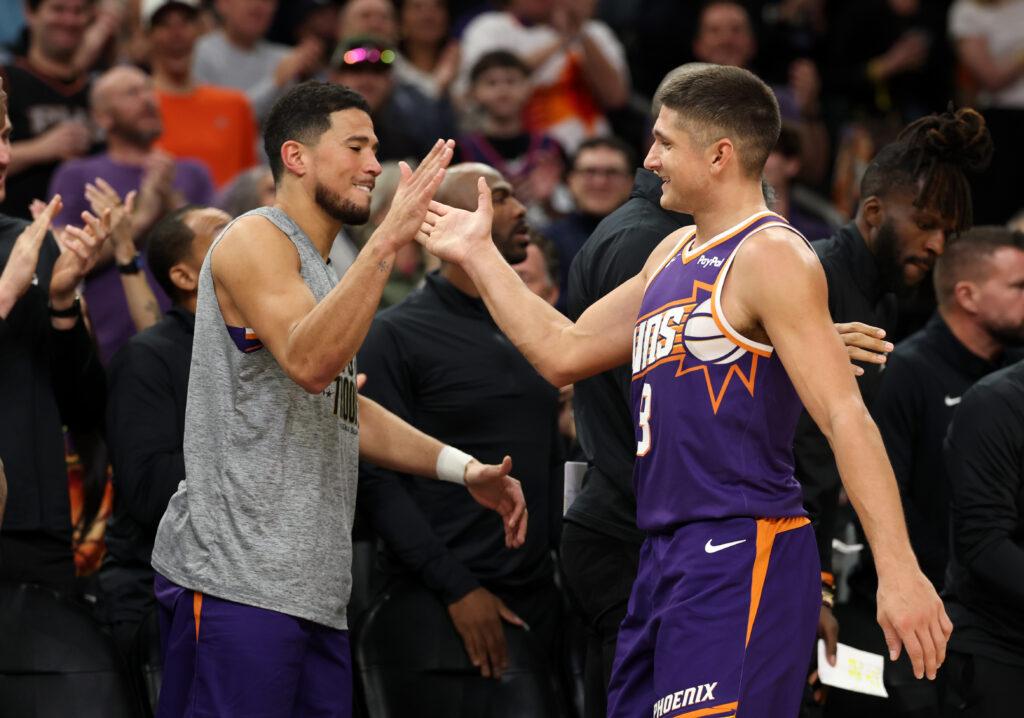Well, it finally happened. Damian Lillard has finally been traded. But it looks a little different than what fans expected. This trade shocked NBA fans as the Blazers and the Heat were stuck in an unusual and drawn-out stalemate for the last three months, and out of nowhere, the Bucks came and picked Lillard up for a surprisingly reasonable price.
In this three-team exchange, Damian Lillard joined the Bucks. The Trailblazers acquired Jrue Holiday, Deandre Ayton, Toumani Camara, and a handful of valuable draft picks. Meanwhile, the Suns got Jusuf Nurkic, Grayson Allen, Nassir Little, and Keon Johnson.
Following the initial trade, the Trailblazers made another move by trading Holiday to the Boston Celtics. In return, they received Malcolm Brogdon, Robert Williams III, and two first-round picks.
These trades signaled a potential shift in the league’s power dynamics. So, as the dust of these trades settles, here are some evaluations of who emerged as winners and losers in the aftermath.
Winners and Losers From the Blockbuster Damian Lillard Trade
Winner: The Milwaukee Bucks
And just like that, the one shining beacon of hope in a bleak and struggling franchise packed his bags and headed to Milwaukee. Despite Lillard’s unwavering dedication and contributions to the Blazers, the organization never quite assembled a team around him that could secure a championship.
Over his 11 seasons in the league, he had the opportunity to play alongside just one All-Star, LaMarcus Aldridge, and even that was almost a decade ago. After enduring three months of uncertainty, this trade to Milwaukee is likely the best-case scenario not only for Lillard but also for Giannis and the Bucks.
The prospect of Lillard teaming up with Giannis Antetokounmpo was hinted at during the previous season. During the 2023 All-Star draft selection, Antetokounmpo chose Lillard as his first pick. Looking back to 2022, when asked about playing with any active player, Lillard had pointed to Antetokounmpo as his choice. Fast forward 18 months and both of their wishes have come true.
How good will this Duo Be?
We’ve witnessed numerous pairs of superstar players generate immense hype and lofty expectations, only to fall short and achieve relatively little when playing together. However, this particular duo has the potential to stand out.
During the last season, Lillard averaged 32.2 points per game on an impressive 64.5% shooting. Achieving an average of 30 points on 60% shooting is a stat line only accomplished by Michael Jordan, James Harden, and Luka Doncic throughout the league’s history. Giannis Antetokounmpo joined this elite list as well, averaging 31.1 points per game on a 60.5% shooting last season. Both of them are coming off historically exceptional seasons, and the last time we saw a duo like this was when Kevin Durant joined forces with Steph Curry and the Warriors back in 2017. Remarkably, in the past 50 years of NBA history, there hasn’t been a duo that averaged at least 30 points per game until now.
Yet, it’s not merely about the dominance of the two individually; it’s about how perfectly their styles of play complement each other. NBA defenses are compelled to devise strategies against both in entirely contrasting ways. With Lillard, defenders have to guard him from well beyond the three-point line in case he decides to take a logo three-pointer, while with Antetokounmpo, you need multiple bodies in the paint to have a chance at impeding his powerful drives. Together, there isn’t a team in the league with defensive personnel capable of effectively countering both Lillard’s deep three-point shooting ability and pick-and-roll expertise and Antetokounmpo’s dominance in the low post.
Recent attempts to create superstar tandems typically involve two players with very similar skill sets. Even though Kyrie Irving and Durant were exceptional individually, their games didn’t seamlessly complement each other. Kawhi Leonard and Paul George, while individually great, possess strengths and weaknesses that are too alike to construct a dynamic offense.
Similarly, LeBron James and Anthony Davis, despite their prowess, share similarities as oversized forwards who tend to operate away from the basket. In contrast, the duo of Nikola Jokic and Jamal Murray functions effectively because they offer distinct skills and positions that complement each other. Beyond Jokic and Murray, who isn’t precisely a superstar-caliber player, the last time we witnessed a duo consisting of two mega stars with such compatible skills and positions was two decades ago with Shaquille O’Neal and Kobe Bryant. Only time will unveil the true potential of this duo, but for now, the near future appears promising for the Milwaukee Bucks.
Winner: The Boston Celtics
After years of falling short, the Celtics are pursuing a new approach to elevate their game. To make meaningful improvements, they have come to terms with the necessity of parting with valuable assets, even if it means trading beloved players. This strategic shift saw them trade Marcus Smart to acquire Kristaps Porzingis and later Malcolm Brogdon, the reigning sixth man of the year, and fan-favorite Robert Williams, gaining Jrue Holiday, who is essentially a better version of Marcus Smart in return. While fans cherished Smart, his occasional questionable decisions and offensive limitations hindered his usefulness. The acquisition of Jrue Holiday helps soften the blow of losing Smart, as Holiday matches Smart’s defensive prowess while adding better offensive capabilities.
The departure of Robert Williams, although he faced injury concerns and wasn’t a strong offensive contributor, is a cause for concern. Williams was an elite shot blocker and a crucial rim protector for the Celtics. Now, the Celtics’ big men primarily consist of an old Al Horford and an injury-prone Kristaps Porzingis. The remaining options, including Blake Griffin, who is thinking about retirement, Luke Kornet, and rookie Jordan Walsh, raise doubts about the Celtics’ defensive capabilities, especially when facing strong big men like Giannis.
Holiday’s addition is a strategic move to counter the emerging duo of Antetokounmpo and Lillard. Nicknamed the “Dame Stopper” during his time in New Orleans, Holiday has proven his defensive prowess against Lillard. In the 2018 playoffs, where the Pelicans faced the Trailblazers, Holiday’s defense held Lillard to significantly lower scoring averages and contributed to a sweep of the Trailblazers by the Pelicans.
While the Celtics’ starting five has undoubtedly improved, concerns loom over their depth. The hope is that emerging players like Lamar Stevens, Oshae Brissett, Sam Hauser, and Peyton Pritchard will step up and make significant contributions as they are likely to get more playing time in the upcoming season.
Winner: The Portland Trail Blazers
Portland has seemingly done a better job of building a team around Scoot Henderson in just one offseason than they ever have for Lillard. Acquiring Deandre Ayton as a franchise center and bringing in a veteran player like Malcolm Brogdon, who can mentor and guide Scoot Henderson, are both steps in the right direction.
In addition to addressing their center position with Ayton and getting a reliable backup in Robert Williams, the Blazers also still have talented players like Jerami Grant, Anfernee Simons, Shaedon Sharpe, and Matisse Thybulle. And on top of all of that talent, they now have an impressive draft haul for future growth and development.
The potential synergy between Henderson, Ayton, and the experienced Brogdon, along with the overall depth and talent on the roster, bodes well for the Trail Blazers’ future. It’s a positive sign that the organization is actively working to construct a competitive team around their emerging star, Scoot Henderson, which has been a crucial aspect of team development that seemed lacking in the past for Damian Lillard.
What This Means for Scoot Henderson
With Damian Lillard, the all-time leading scorer for the Portland Trail Blazers, no longer leading the offense, Henderson will now lead this offense. Henderson steps into the role of orchestrating the team’s offense, absorbing Lillard’s share of on-ball volume and running the pick-and-rolls that were a staple of Lillard’s game. The addition of Deandre Ayton, a dynamic pick-and-roll partner, enhances Henderson’s developmental context and provides him with a more versatile option in the pick-and-roll compared to Jusuf Nurkic.
Henderson’s style of play differs from Lillard’s, relying on his exceptional speed, explosive power, and mid-range finesse to generate offense, as opposed to Lillard’s mastery as an all-time great perimeter shooter. While fans might miss Lillard’s signature logo threes, Henderson’s game is expected to bring highlight reel dunks and a unique approach to creating scoring opportunities.
The departure of Lillard has ultimately created a more favorable situation for Henderson, affording him greater freedom to experiment and evolve as an on-ball creator. He can work towards reaching his potential without the constant comparison to Lillard, and the team can tailor the offense to suit Henderson’s skill set best. It’s evident that the Trail Blazers already have a capable replacement in Henderson to step into the shoes of their franchise star of the last decade.
Loser: The Phoenix Suns
The Suns got worse with this trade. They traded Ayton because the ownership didn’t feel he fit in with the roster, and he, along with Durant, Devin Booker, and Bradley Beal, used up almost all of the Suns salary. While the Suns believe that Jusuf Nurkic is a better fit for the team as they are trying to win a championship, and while Nurkic is a solid center, Ayton is much better than him. They now have an older Center who is worse at scoring and rebounding than Ayton.
The Suns also got Grayson Allen, Nassir Little, and Keon Johnson in the deal, which should help with some of their depth issues. They have a player who consistently intentionally trips players in Allen. They received a young forward in Little, who could be a promising young talent. Finally, the Suns got another young player in Johnson, who likely will not get much playing time. the Suns depth absolutely got better, but a big four of Durant, Beal, Booker, and Ayton would have been very fun to witness.
The trade involving Deandre Ayton seems to have generated mixed feelings. Ayton, a talented young center, was seen as a key asset for the Suns, and his departure has raised concerns among fans and analysts. The decision to trade Ayton was driven by financial considerations and the belief that Jusuf Nurkic would better fit the team’s championship aspirations.
While Nurkic is a solid center, Ayton’s overall skills, particularly in scoring and rebounding, surpass Nurkic’s. The addition of Grayson Allen, Nassir Little, and Keon Johnson does address depth issues for the Suns and introduces promising talent. However, Grayson Allen’s history of on-court incidents, such as intentional tripping, raises questions about his behavior and its potential impact on the team’s dynamics. The Suns have said they believe they are getting a “scrappy” player in Allen, but others would call him a “dirty” player due to his numerous incidents from his college days as well as early in his NBA career.
Ultimately, the Suns’ depth has improved, but it isn’t clear yet if the team made the right decision in parting ways with Ayton, given his abilities and potential contributions to a hypothetical “big four” alongside Durant, Beal, and Booker. The trade’s full impact will become clearer as the season progresses and the new roster settles into their roles.
Loser: The Miami Heat
The Miami Heat’s offseason revolved around the potential acquisition of Damian Lillard, and their pursuit didn’t come to fruition. This left them without the significant upgrade they were aiming for. They also failed to retain notable contributors like Max Strus, Gabe Vincent, Victor Oladipo, and Cody Zeller, which has raised concerns about the team’s depth and overall improvement.
The Heat’s inability to secure Lillard or make substantial additions leaves them well behind teams like the Bucks and the Celtics in terms of roster strength and potential. The success and competitiveness of the Heat moving forward will depend on how they adapt to this unexpected turn of events, utilize their existing roster, and potentially explore other avenues for improvement during the season.
Main Image: Benny Sieu-USA TODAY Sports



